 |
 |
| Poor chair | Makeshift lumbar support |
Principles affected
Related pages
Workstations:
Background
The problems with sitting at workstations fall into several categories.
- Inadequate design or choice of chairs
- Fatigue from constant sitting
- Employee lack of knowledge about proper adjustment
Objectives
- Keep the spinal column in its neutral, S-curve posture
- Help position the person at an appropriate height for the work
- No pressure points on buttocks or behind knees
- Minimize shoulder fatigue
- Ability to change position
- Note: The difference between the underlying principle vs. common approaches to meeting the principle is especially important here. For example, a chair does not need to be height adjustable to be “ergonomic.” There are many times when a fixed-height chair is fine, if it fits the person correctly. Height adjustment is certainly a good feature of a chair and usually something to require in a chair. But that’s not the point — the point is meeting the underlying principles, i.e., neutral posture, eliminating pressure points, and so forth.
Ideas and Options
Features of a good chair
 |
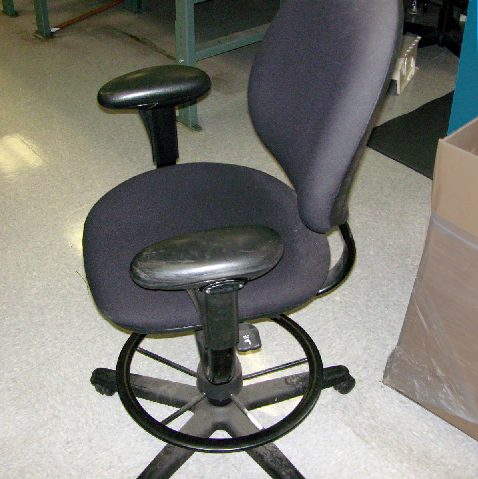 |
| Good shop chair | Good chair for light operations |
Proper lumbar support — The backrest should fit snugly into the small of the back, curved to fit the lumbar spine. Usually this entails a back rest that can be adjusted up and down as well as forward and backward. In most chairs, the backrest must be separate from the seat pan in order to have these functions.
Height adjustment with pneumatic lift — Almost all new chairs have this feature because of the key benefits it provides:
- Accommodates individual employee stature
- Permits adjustment for different tasks
- Allows occasional change of posture to reduce fatigue
- Enables adjustment to prevent pressure points on buttocks or behind knees
- Good cushioning — to prevent pressure points.
Note: There are some personal preferences regarding issues like thickness and shape of the cushioning that are not ergonomics issues per se. As long as there are no pressure points, the ergonomic objectives are met.
Related features
Arm rests — Arm rests are usually required for office and computer work, but not necessarily for industrial work. The purpose of an arm rest is to relieve fatigue on the shoulder muscles. Often in production areas, it is better to provide the necessary arm support on the workstation itself. Depending upon the task, arm rests on the chair may be a hindrance to arm movement or they may be appropriate.
Covering — Fabric is typically not used in production areas that are dusty and/or where more than one person uses the same chair. Coverings such as polyurethane are easier to clean.
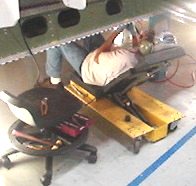 |
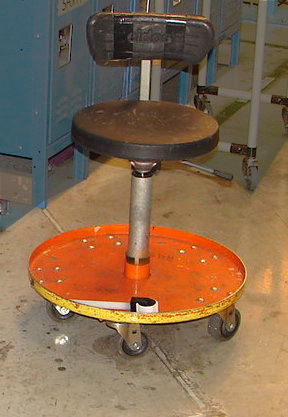 |
| Creeper and low stool on casters | Low stool on casters |
Casters vs. glides — Usually the flooring in production work areas is hard and casters can roll too easily. Casters are usually needed for carpeted floors where sliding a chair would otherwise be difficult. However, there are manufacturing operations where casters provide the mobility needed to perform tasks, such as on small stools used to work on low sections of large products. Good wheel selection can help in these situations.
Slant vs. right angle
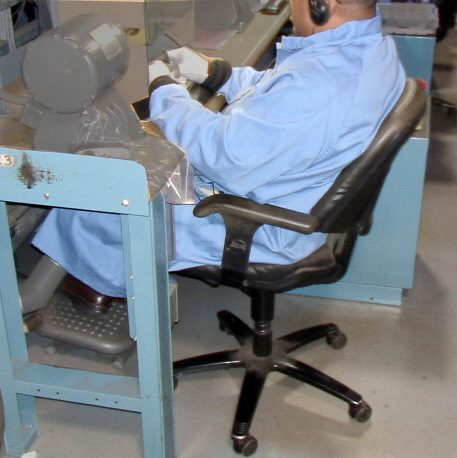 |
 |
| Good feature — Slightly reclined backrest | Good feature — Forward slant of seat pan |
A common misperception is that the best orientation for a chair is at a perfect right angle. This orientation is not “wrong,” but it is better to lean back slightly or tilt the seat pan forward. The scientific evidence for a semi-crouch position shows that the right-angle position tends to flatten the natural curve of the lower back or even curve it the wrong way.
Lumbar support
 |
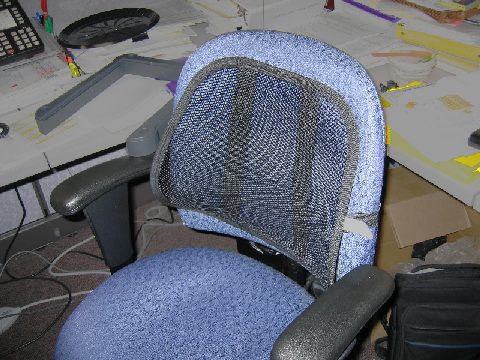 |
| No support | Added support |
A very common issue is that the chair backrest cannot be moved forward sufficiently when employees sit upright at a workstation. Ideally, the chair should be capable of this function. However, it can be satisfactory to add lumbar support, like the wire mesh version shown above right. Hundreds of cushions are available.
 |
| Older shop chair with good shallow seat pan |
Excessive depths of seat pans for benchwork is a shortcoming of virtually all shop chairs on the market today. The back rests simply do not come forward far enough to provide sufficient lumbar support. Ironically, some older chairs are much better in this regard.
The old shop chair shown above has an unusually shallow seat pan, which makes sitting surprisingly comfortable given its antique appearance and lack of cushioning. This chair is also very adjustable, although it requires a screwdriver and wrench and thus is not changed quickly.
Lean stands
 |
 |
| Rest bar used by U.S. Postal Service | Back rest, like leaning against lamp post |
Lean stands provide an option for specialized situations, such as where a job that mostly requires standing or walking, but occasionally offers a micro-break. A good example is operating a machine that has a cycle time that is longer than the time needed for the employee to perform other tasks. Standard chairs are not suitable for these situations because they are not fast and easy to get up from. The lean stand provides a way to “take a load off,” but yet allow instant standing.
Common pitfalls
- Lean stands should not be used in place of a good shop chair with good lumbar support.
- It is tempting for employees to try to sit on the lean stand and thus not use it appropriately. The point of a lean stand is to provide an occasional alternative to standing, but the body weight should still be supported by the legs. The back rest style may be a better choice since it provides some relief from constant standing, but does not offer the temptation to sit.
Employee training
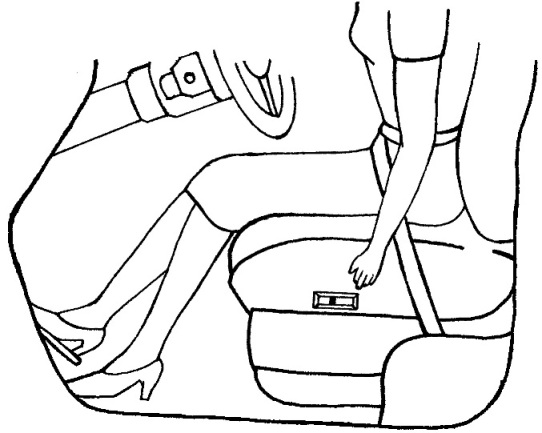 |
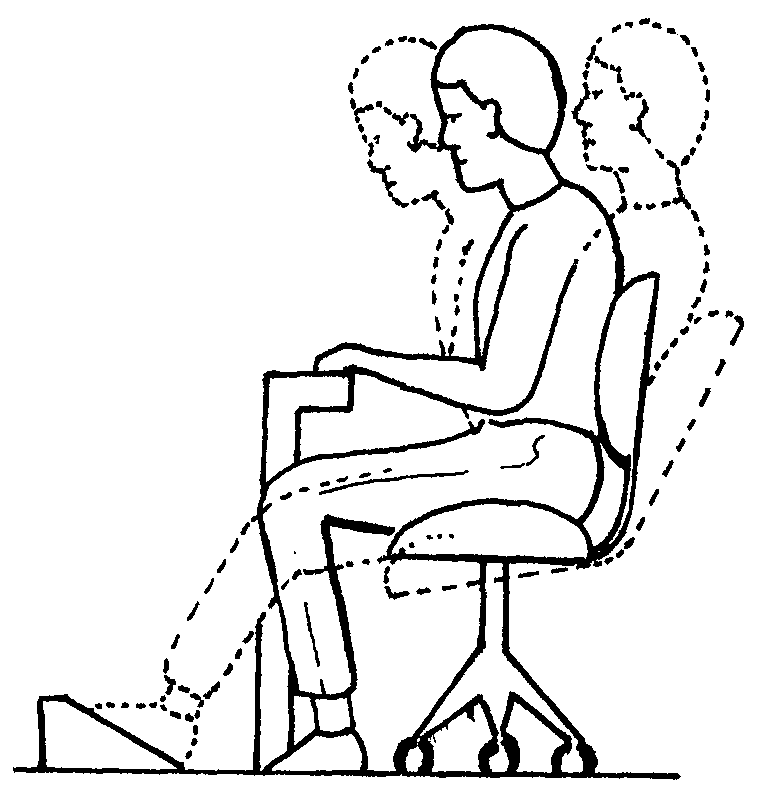 |
| Unconscious adjustment of car seats | There is no single posture that is correct for a full workday. Movement and change in position. |
Most people are not yet accustomed to adjusting chairs or any other equipment in the workplace. At some point in the future, however, it will be part of unconscious daily habits, just like we do with car seats. Until we reach that point, training is needed:
